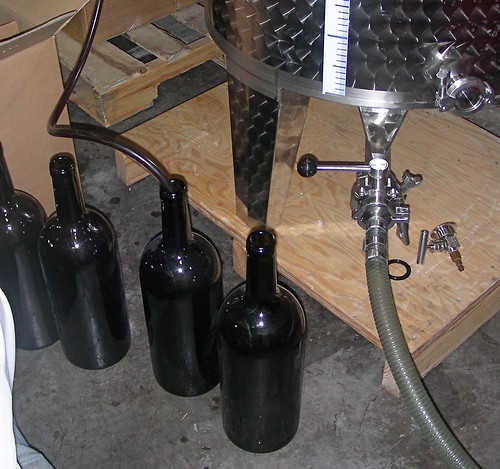 Last week was the last step of our winemaking journey: bottling. We first had to decide that our Inkgrade Cabernet was ready: dark purple color — actually noir d'encre, or black as ink, like the name on the label —, impressive nose of currants and blackberries, definitively tannic on the palate, some good acidity, long finish. “That's obviously a wine that is going to age well” acknowledged Crushpad winemaker Camille Benitah who was tasting the final version of the wine with us.
Last week was the last step of our winemaking journey: bottling. We first had to decide that our Inkgrade Cabernet was ready: dark purple color — actually noir d'encre, or black as ink, like the name on the label —, impressive nose of currants and blackberries, definitively tannic on the palate, some good acidity, long finish. “That's obviously a wine that is going to age well” acknowledged Crushpad winemaker Camille Benitah who was tasting the final version of the wine with us.Then we moved to the bottling area where cases of double magnums were waiting for us. Yes, my friend Rick wanted most of his share of the barrel in double magnums! “Double magnums are great for aging,” he explained, “and what a treat when you open one in front of your guests!” (if you have any doubts about large size bottles, read this piece). The only problem was that these bottles were too big for the bottling equipment therefore filing and corking had to be done by hand. This process was rather time consuming and unfortunately, we had to leave before the end.

Bottling equipment for standard size bottles and magnums only

Filling the double magnums

Inserting a wine cork
We are now moving into the next stage: resting and aging. I foresee that this one will last for a while.
Related posts:
• Winemaking step #9: fining
• Winemaking step #8: blending
• Winemaking step #7: barrel tasting
• Winemaking step #6: after the malolactic fermentation
• Winemaking step #5: pressing the wine
• Winemaking step #4: getting ready for the pressing
• Winemaking step #3: monitoring the fermentation
• Winemaking step #2: inoculation of the must
• Crushing at Crushpad
• 2006 Cabernet Sauvignon Ink Grade Vineyard Howell Mountain
Technorati tags: wine food & drink
No comments:
Post a Comment